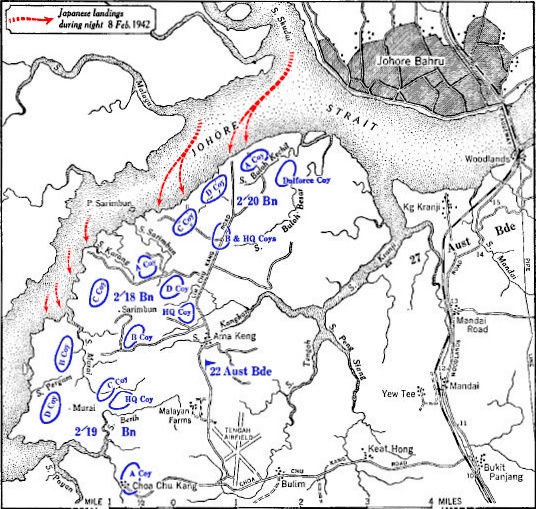
 .
.Battle
At 8.30pm on 8 February, Australian machine gunners opened fire on vessels carrying a first wave of 4,000 troops from the 5th and 18th Divisions towards Singapore island. The Japanese assaulted Sarimbun Beach, which was held by the 22nd Brigade.
Fierce fighting raged all day but eventually the increasing Japanese numbers — as well as their superiority in artillery, planes and military intelligence — began to take their toll. The Japanese exploited gaps in the thinly-spread Allied lines such as rivers and creeks. By midnight, the two Australian brigades had lost communications with each other and the 22nd Brigade was forced to retreat. At 1am, further Japanese troops were landed and the last Australian reserves went in.
Towards dawn on 9 February, some elements of the 22nd Brigade had been overrun or surrounded, and the 2/18th Australian Infantry Battalion, in the centre, had lost more than half of its personnel. The 2/20th Australian Infantry Battalion, on the right flank was also heavily committed. At the same time, the 2/19th Australian Infantry Battalion, on the left, was being outflanked, and only "B" Company faced the initial landings by the Japanese.
Percival maintained a belief that further landings would occur in the northeast and did not agree to reinforce the 22nd Brigade until Tengah Airfield itself was threatened. However, before limited British and Indian infantry reinforcements arrived, the badly-battered Australian and Singaporean units, along with the Jinds, had retreated to take up positions on the "Jurong Line", stretching south from the village of Bulim. Tengah Airfield was taken by the Japanese at around midday on 9 February.

Aftermath
Shortly after dark on 9 February, three British Fairmile B motor launches were sent on a raid up the western channel of the Straits of Johor, adjoining Sarimbun Beach. Their objective was to attack Japanese landing craft and communications. They came under fire from enemy forces on both shores, but pressed on almost as far as the causeway. A few Japanese landing craft were sunk before the launches returned down the channel, reaching Singapore safely and suffering minimal damage. Some Allied soldiers saw this as an example of effective defensive tactics that were used too little and/or too late by their senior commanders.

No comments:
Post a Comment